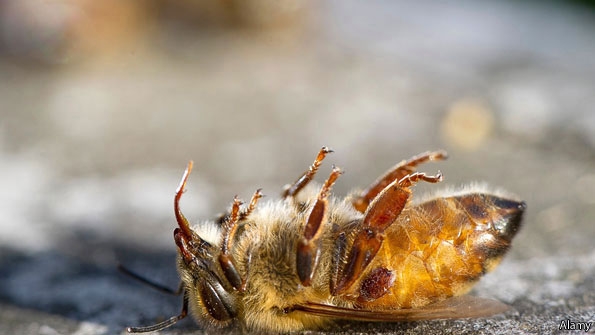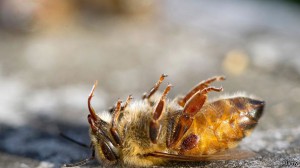Les pesticides nuisent gravement à la santé des abeilles

Dans son édition du 31 mars 2012, The Economist publie un article inquiétant concernant l’impact des pesticides sur la santé des abeilles et leur éventuelle disparition. Nous publions cet article in-extenso et appelons solennellement à l’arrêt progressif mais programmé de l’usage des pesticides dans l’agriculture. Actu-Environnement a également publié des extraits de l’étude de l’INRA cité par The Economist. Vous pouvez lire cet article: ICI.
IN THE winter of 2006 beekeepers in America noticed something odd—lots of their hives were dying for no obvious reason. As the months passed, reports of similar phenomena began coming in from their European counterparts. Mystified scientists coined the label “colony collapse disorder” (CCD) to describe what was happening. Since then, much brow-sweat has been expended trying to work out just what CCD really is.
Dying bees are a problem, and not just for apiarists. Bees pollinate many of the world’s crops—a service estimated to be worth $15 billion a year in America alone. And there is no shortage of theories to explain the insects’ decline. Climate change, habitat destruction, a paralysing virus, fungal infection and even a plague of parasitic mites have all been proposed. But one of the leading ideas is that the bees are suffering from the effects of neonicotinoids, a class of commonly used pesticides, introduced in the 1990s, which are toxic to insects but much less so to mammals.
Two papers published this week in Science lend weight to this idea. The first, from a group led by Penelope Whitehorn and David Goulson of the University of Stirling, in Britain, examined the effects these insecticides have on bumblebees, which are closely related to honeybees. Bumblebees are less studied than their honeybee cousins, but they also pollinate many commonly eaten crops, including strawberries, raspberries and runner beans.
The two researchers and their colleagues raised 75 bumblebee colonies in their laboratory. They exposed some, via contaminated pollen and sugar water, to high doses of imidacloprid, a type of neonicotinoid insecticide. Others were exposed to low doses (half as much as the high dose), or to no dose at all. Then, after two weeks of this treatment, the colonies were taken into the outside world and left there for six weeks, to see how the bees did.
All of the doses of imidacloprid, both high and low, that Dr Whitehorn gave her bees were “sublethal”—in other words, insufficient to kill the insects outright. Firms that produce pesticides, and the authorities that regulate them, are aware of the importance of bees to food production, and new products must be tested to make sure they are not fatal to helpful insects. But Dr Whitehorn found that even non-lethal doses of pesticide were bad for bees. Both the high-dose and the low-dose colonies grew more slowly than the undosed ones, gaining 8-12% less weight on average.
More importantly, the pesticides drastically inhibited the production of queens, which are needed to establish new nests each spring. (Unlike those of honeybees, bumblebee colonies do not survive the winter; they must be refounded by a hibernating queen.) The undosed colonies produced 13.7 queens, on average. Those given a small dose of insecticide produced two. Those given a high dose produced just 1.4. Worryingly, even colonies given the high dose may have got off lightly compared with their wild brethren. The researchers note that another British study found levels of imidacloprid in rape crops that were seven times higher than the food supplied by the researchers.
Dr Whitehorn’s paper does not propose a mechanism by which pesticides do their damage. But the second study, by a group led by Mickaël Henry at the French National Institute for Agricultural Research, in Avignon, may shed some light on the matter. Inspired by previous laboratory-based work, which had suggested that sublethal doses of neonicotinoids damage honeybees’ memories, their ability to forage, and their ability to navigate back to their hive afterwards, Dr Henry decided to conduct some tests in the wild.
To that end, he and his colleagues glued tiny radio transmitters to the thoraxes of worker bees. These triggered a detector on the hive whenever a worker bearing one returned from a foraging trip. Some hives were given realistic doses of thiamtethoxam, a variety of neonicotinoid, while others were left alone. Dr Henry found that around twice as many treated bees as untreated ones failed to return to the hive. That, mathematical models indicate, might easily cause a hive to collapse.
Colony club
Moreover, even if it did not do so alone, it could be a contributing factor. Many researchers believe the label “colony collapse disorder” covers a multitude of problems; that would account for the long list of possible causes. But neonicotinoids have the explanatory virtue of being a fairly recent development and also one which, as these two pieces of work suggest, could be a common factor in weakening a colony without actually pushing it over the edge. The killer blow would then be administered by something else: a mite infestation, perhaps, or a fungal infection, or whatever else happened to turn up that a healthy hive would have shrugged off. A paper published earlier this year in Naturwissenschaften, for example, showed that even small doses of neonicotinoids weakened bees’ resistance to Nosema, a common fungal parasite.
A few countries, including France, Germany and Slovenia, have already restricted the use of neonicotinoids because of worries about their effects on bees. It would help other places that are thinking of following suit if more realistic trials were conducted in the future, in conditions that mimic nature as closely as possible in the way that these two experiments have done. That might be more expensive than the present way of doing things, in which tests are mostly confined to laboratories and are concerned with finding out how much insecticide is needed to kill bees outright. But the growing evidence that insecticides damage bees in subtle ways means it would be money well spent.
